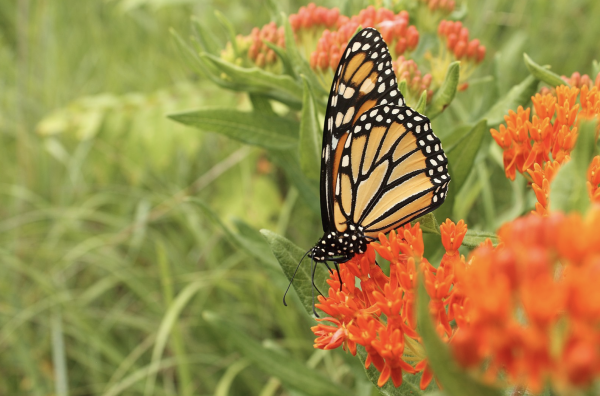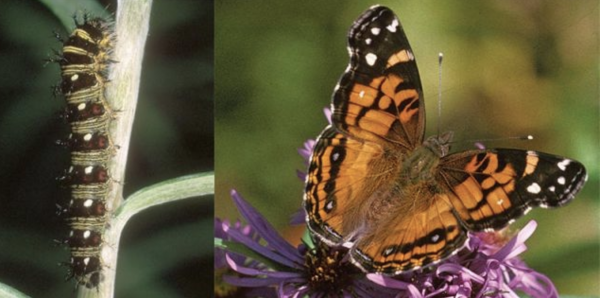Butterflies existed as far back as 40 to 50 million years ago during the mid Eocene epoch. Around 18,000 species of butterflies are known. The United States is home to about 750 species. There are about five families of butterflies based on their anatomy. These fab flyers are the most familiar of insects thanks to their brightly-colored wings and frequent visits to flowers.
Butterflies and moths belong to the order Lepidoptera, which is a combination of two Greek words, meaning ‘scaly wings’. These are the only two group of insects with scales covering their wings. Lepidoptera is one of the most recognizable orders of insects, containing more than 250,000 known species. Out of these, 18,000 are species of butterflies. They occur almost everywhere from Arctic Tundra to tropical rainforests.

Monarch Butterfly (Danaus plexippus) lapping up flower nectar. Photo © Kopph. Image Source: Wikimedia Commons
Butterflies normally spend a lot of time around plants, which is why they may be harmful to some of them. However, they are critically important to most other plant species that depend on insects for cross-pollination. Therefore, before we deep dive into what do butterflies eat, let’s first explore a little bit about these insects.
They are very active in daytime and also have excellent eyesight. There are 6,000 lenses inside the eyes of a butterfly, which is why they can see ultraviolet light. Despite the fact their sense of smell is poor, butterflies tend to rely more on their smell (rather than visual cues) in order to locate nectar plants. Butterflies have taste sensors on their feet. As soon as they land on a leaf, they can decide whether or not their larvae can feed on it.
The larvae coming out of tiny eggs of butterflies are known as caterpillars. They are voracious creatures and begin chewing down persistently on the leaves of the host plant as soon as they leave their eggs. Depending upon the adult female butterflies, these little critters may eat one or several plant species. A butterfly develops through a complete transformation process known as metamorphosis.
What Do Butterflies Eat in the Wild and in Captivity
A fully grown caterpillar changes into a butterfly in a kind of vessel called pupa. After few weeks (or perhaps months) the hardened case around it splits open and out comes a strikingly patterned butterfly. At first, the wings are wet and so the butterfly waits for them to dry off. As the wings dry out, the butterfly takes to the air in search of flowers.
Monarch butterflies are one of the world’s most well-studied species of butterflies. They are also among one of the most loved insects of North America. There are two groups of monarchs: western and eastern monarchs. They are native to North and South America and their caterpillars feed only on the leaves of a milkweed plant. At the end of summer or early fall, monarchs head south for winter and some of them may fly as far as 3,000 miles.
Adult female butterfly knows what kind of leaves or stems are suitable for its caterpillars. That’s why she picks out leaves of a certain plant species for laying her eggs. This is because caterpillars eat their way out of the eggs and spend their entire lives eating the same plant or sometimes the same leaf.

American Lady (Vanessa virginiensis) caterpillar. Image Source: Northern Woodlands Magazine
Even though caterpillars feed on the same plant leaves, a fully developed butterfly flies around and look for other suitable food sources. Adults sip liquids from a variety of flowers thanks to their tube-like tongue or mouthpart known as proboscis (which acts like a straw).
Butterflies often feed on flower nectar but some of them (especially in the tropics) also sip liquids from rotting fruit or carrion, animal dung or ooze from trees. They especially love sipping liquids from a freshly dropped pile of dung, which gives them a lot of essential salts and amino acids (otherwise absent in plants). This behavior by flocks of butterflies is known as mud-puddling.
Since butterflies probe for nectar in a wide range of wildflowers, they usually prefer flowers in clusters (such as spirea, goldenrods) and those that have some kind of landing platforms or pads.
Some of the plants with clustered flowers providing suitable landing pads for butterflies are showy stonecrop, milkweed, garden phlox, and joe-pye weed.
Moreover, there are some other composite flowers that have pretty nice landing platform like black-eyed susan, goldenrod, blazing star, zinnia, and purple coneflower.
The quality and quantity of nectar differs considerably depending upon the fertility of soil as well as how much sunlight the plant receives during the day. Typically, plants that get at least six hours of sunlight possess more nectar than others.
Butterflies typically favor brightly-colored flowers like red or yellow. Besides, most of them visit flowers with deeply hidden nectar.
Actually, nectar is a very good source of water and sugar for butterflies, along with some other essential nutrients like proteins, vitamins, amino acids, and enzymes.
Nectar of flowers in early season provide a very good and important source for those butterflies that live through the winter. Some of these sources include lupines, lilacs, and dames rocket.
Likewise, flowers of late season provide good source for those that end the season such as butterfly bush, Helen’s flower, Asters, and goldenrod.
Flowers that bloom in late fall tend to possess less nectar compared to earlier season flowers. As a result, butterflies that acquire nectar from such flowers will have to make a lot of visits to get nourishment.
The caterpillars of almost all butterflies eat plant matter. However, some of them may feed on seed pods and seeds. Majority of caterpillars feed on related species of plants. For instance, caterpillars of Pearl Crescent butterfly will typically snack on species of asters. That said, the Harvester butterfly caterpillars consume small sap-sucking insects called aphids.
In summer, we often see butterflies huddled around in some unusual places like mud puddles. In reality, they suck up salts and minerals present in that moisture.
The caterpillars of Black Swallowtail snack on the leaves of parsley, fennel, dill and carrot. Likewise, the larvae of Painted Lady butterfly consume thistle leaves.
In addition to these, some herbaceous plants that prove beneficial for butterfly larvae include cabbage and related cole crops, alfalfa, wormwood, sunflower, clover, and hollyhock and other members of mallow family.
There are quite a lot of trees that provide pretty good food source for butterfly larvae. Some of these include hackberry, oak, willow, birch, ash, hornbeam, sumac, shadbush, elms, and poplar.
Sources & Further Reading:
“All About Butterflies“. University of Kentucky, College of Agriculture, Food and Environment. Accessed 23 March, 2021.
“Butterflies“. Department of Systematic Biology, Smithsonian Institution. Accessed 23 March, 2021.
“The Butterfly Conservatory“. American Museum of Natural History. Accessed 23 March, 2021.
“Butterfly“. San Diego Zoo Wildlife Alliance. Accessed 23 March, 2021.
“Butterfly Pollination“. U.S. Forest Service. Accessed 23 March, 2021.
“All About Butterflies“. Cambridge Butterfly Conservatory. Accessed 23 March, 2021.
P. Perry, Dr. Leonard. “Feeding Your Butterflies“. University of Vermont Extension, Department of Plant and Soil Science. Accessed 23 March, 2021.
Britannica, The Editors of Encyclopaedia. “Butterfly“. Encyclopedia Britannica, 16 Apr. 2020, Accessed 23 March 2021.
Harris, M. 2002. “Lepidoptera” (On-line), Animal Diversity Web. Accessed March 22, 2021
